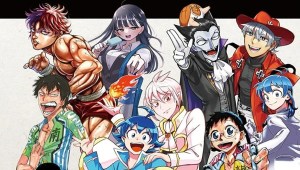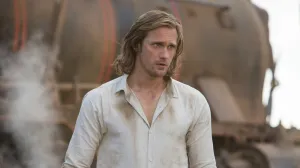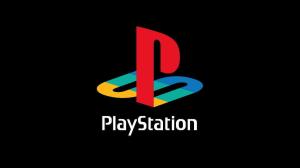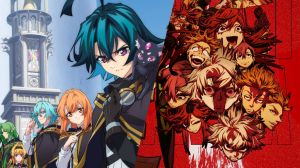In the days leading up to the series finale of Agents of SHIELD, we sat down with production-side visual effects supervisor Mark Kolpack and FuseFX’s Kevin Yuille to chat about the closing moments of the hit ABC show. Taking a deep dive into the CGI work on the time-traveling storyline, both Kolpack and Yuille detail their favorite moments from the show’s final season and on a macro level, the series as a whole.
Videos by ComicBook.com
Though work has wrapped on the Marvel Television series, both VFX mainstays also teased their future in the industry, though, in typical Hollywood secrecy, both remained mum on their exact plans for their immediate post-SHIELD futures. Keep scrolling to see our full chat with the duo
Time-Traveling Timelines
ComicBook.com: I’m not sure which one of you two want to take this first, but you get the seventh season storyline and you see time travel, time streams, time loops, all sorts of that stuff. I’m sure as visual effects artists, your heart’s kind of started beating a little bit faster as soon as you found that out, right?
Mark Kolpack: Yeah, I’ll go first. Okay. So since my overall responsibility as the visual effects supervisor is that I work for the production, I get the scripts, I break down the scripts and I work with my producer, Sabrina Arnold, and we send things out. And FuseFX has been from the very, very beginning, our sort of lead house, a few of the houses that we’ve used over the seasons. They’ve been there from the beginning, so they do a lot of heavy lifting work as does another house named CoSA, but when we got… It’s funny, every season we have evolved as a show, both from a story standpoint and of course a visual standpoint. Things always progress.
We got through with season six and season seven came right on the heels of it. And yeah, I was going to be like, “Oh, they’re back in 1931,” as we ended season six. We sort of picked up steam as the season went on and things evolved and things became bigger and jeopardy became bigger and everything became much more complex. But when it’s all said and done, the odd thing is, when I look back at all 13 episodes, and when I look at all the work that we did, we did actually a really fair amount of work. For a season, I felt very light for us.
Kevin Yuille: Yeah. If I could add to that, the schedule was, is we delivered season six, and that was a pretty grueling delivery just because of how big it ended. But I don’t think everyone realized that it was back to back for us. So we kind of rolled right into season seven. There was a little break, but it wasn’t the typical schedule where we wrapped, then we have four months off or something, we went kind of right into the next season. And I don’t know, I think for us that it was nice that it wasn’t so heavy the first five or six episodes. Because it gave us a breather and it was kind of nice to do some of the more traditional kind of invisible visual effects where yeah, we did map painting, set extension, stuff like that. But the audience may not have noticed the work we did, it wasn’t too obvious. It wasn’t as full CG environment as some of the previous shots or whatnot, but…
I mean, some of the stuff we did in episode 702, which no one would even realize in a million years, was the set work in New Brunswick, Canada, wherever we were. We shot down in San Pedro, but changed out the whole thing when Enoch got left behind. So you see the Zephyr, the advantages, that whole environment beyond there was a creation. We got rid of San Pedro, California, and put in New Brunswick, Canada. And then a couple of other shots with an old Model T or Model A, I don’t know what model it was. But where the car was in a sort of a little alleyway or a little area of a loading dock and behind that was again, part of the map. So if you’re not really aware of what we’re… I mean, those just look like real shots that they pulled off and you would never in a million years think, “Oh, that’s a visual effect.”
Production Timelines
Before season seven premiered, I mean, it was in the can for quite a while, right? Almost a full year, I think. Did that afford you more time to refine the stuff or did you treat it like a normal schedule and get it out on time just so they had it all ready for release?
MK: Well, we went ahead and this was all sort of on a normal schedule. I mean, like Kevin was saying, we finished season six, but for us in production, we went from six to seven, and they were still finishing up some things in six as we were still working on just beginning with shooting season seven. We have a hard date out at the studio, at the Culver Studios in Culver City, California. The lot is now completely taken over by Amazon, so we had this sort of…we finished up in early October. We were supposed to be done at the lot in August or something like that, or September, but we stayed a little bit longer there and then basically Sabrina and I had to work sort of remotely, I guess, because we were out of the actual production space when we delivered in early October. So 713 went a month longer because we had so many episodes to still finish up in season seven prior to that, that I think we had three episodes that were finishing up, but we didn’t get all this extra time from last October, 2019 to now that it’s airing. Everything gets mixed, 713 mixed in mid-October. And then they’ve been sitting on all the episodes all this time.
We talked time-travel and stuff. I know through the creative process, each creator, each artist wants their own unique voice naturally, but ultimately we’re all inspired by something. What were some of the properties both of you drew inspiration from on the time-traveling front?
MK: Well, I’ll let Kevin go first. I mean, I got my things, right? I talk more than I should, so I’ll let him talk.
KY: Okay. I guess on the time-traveling front… That’s an interesting one. I think for me, I love kind of the look of some of the 80’s movies. Back to the Future I think is probably in my top 10, certainly top 10 sci-fi of all time. I don’t know. There’s this whole resurgence of eighties movies and stuff like Stranger Things and all that. But I think for me, it’s like the look of, let’s say, the sphere thing. What do you call that Mark? The sphere, the time-
MK: Time jump sphere? Time jump sphere. Yeah, that’s it. Yeah.
KY: Yeah. I think the inspiration from that was just, I don’t know. I wasn’t honestly referencing a specific movie, but I think it was just more, we wanted it to be a clean, kind of a dimensional, I would say… God, I can’t even put the words. Basically I would say that we drew inspiration from some of the really amazing concept artists that we have. I mean, I would have to ask them where they-
MK: I mean there was… I’ll help him out a little bit here. There’s a time bubble because there’s definitely been a lot of interesting, creative ideas here. One of the things is, is that, when I break down a script, I do a few different things besides the layout, the technical and the creative and whatnot. But I actually am often watching on my monitors. I’m actually pulling up, Googling different sort of concepts and things and ideas that I see in my head that I would like to just get us some visual reference for artists in the different facilities. And one of the things about this that really drew me to the show, was the idea of a time bubble and the fact that it would create a clamshell and it was energy that was surrounded. And when we first started, it got a really a little too out of hand, I think. There was a lot of electricity and things going all across the surface of Zephyr One. And then it became a refinement after that. It’s just taking out elements, it’s just making things more and more subtle. So therefore it was just this energy bubble that expanded and it just went away.
So for me, it’s about usually mining the internet and I just start looking for concepts and weird search phrases and things like that because I’ve looked at all different kinds of art and things that I could actually take from here and there and put together and sort of make a look or at least give me some visual reference. So guys, like Kevin, can see that and go, “Oh, that’s interesting.” And then they’ll bounce that around their talent over there, and then when I meet with them or talk with them, they’ll say, “Okay, so we’ve got this reference. It’s really cool. Is there anything else that this, or we were thinking of maybe adding this to it.” I go, “That sounds like a cool idea.”
KY: Well, thank you for the save. But yeah, no, I think it’s right. I think a lot of it is looking for reference that’s out there on the internet. And that’s the kind of stuff where Mark will have an idea and then myself and the CG supervisor will kind of also go through the web and find things that we find visually interesting that kind of fit the look that Mark is looking for. What I wasn’t touching on before is we do have concept artists that we then heavily rely on. It saves a lot of time. Obviously, you don’t want to kick around in FX and just kind of guess as to what a look is for a specific effect. We establish a look with our concept designers, like Jeremy Nelson. And as Mark can attest to, he’s one of our stars at Fuse. And he’ll sit with Mark, he takes in all of these reference photos that Mark will have, or that myself or the CG supervisor has and he’ll kind of, it’s a blank slate for him and then he gets the ideas and then goes crazy with it.
MK: Jeremy Nelson is just a really stupidly talented guy. Very easy to work with, understands Kolpack talk, which is really helpful. So, yeah. So it’s great because I mean, even with the Vrellnexians and with the Trawler and all these different kind of assets that are done in CG, that’s a very labor-intensive world and costs money, right? So you don’t want to spend a lot of design time in the 3D world. You want to get the impression and the sort of roadmap of what needs to be created properly done ahead of time, in 2D. It’s just faster. Iterations can be turned around really quickly. Take out this, I don’t want claws, I want bigger claws, I want fangs, I want no eyes, I want eyes, I want the Trawler to be bigger, thicker. So he’s able to turn it around. And then once we get the concept, I’ll say, “Okay great. Now we can take this into modeling and that kind of thing.” And they’ll start to find the textures and everything else and start making it great.
Working for the Long Haul
I know Mark, you’ve been with the show for quite some time, right? Kevin, have you been with it all along too? Or how long have you been attached to the show?
KY: I started on the pilot, I did some of those… I don’t know if you remember, but when they introduced the bus coming out of the hangar. Yeah, so I’ve been with the show since the beginning. And Kevin Lingenfelser was the visual effects supervisor for Fuse through season three. And then it was at that point that myself and David Rey together, we split, we were co-VFX supervisors. That’s even when we started to kind of take the reigns, Kevin was there for the Ghost Rider. But yeah, I’ve been around, God, it’s been six years. It’s insane. I have very vivid memories of the first shots I delivered. It’s creepy how long ago it was, though the memory is still pretty vivid.
I mean, I came on in the pilot, I was hired for the pilot and stayed with the show and we had to set a level in the visual effects look that would be somewhat on par or feel kin to the feature universe. And this was Marvel’s first live-action show, so you have to remember that before that, if you went back to something back in the seventies when the sort of Spider-Man was running around, and it was really schlocky kind of early Marvel’s TV shows and it was really important to me when I was interviewing to supervisor of the show was to basically protect the brand.
I said to them in the meeting, I said, “We don’t do this right, we’re going to end up losing the audience pretty quickly because they’re going to go, ‘Oh, this is horrible compared to what the movies are,’” so we didn’t have the money or the time to do what the movies do, but what we did do is always pick our battles and continually make the stuff that we were doing the best that we absolutely could to maintain the integrity within the Marvel brand. So like I said, “Well, it’s not the feature, it’s kin to it. It feels familiar, feels covered,” and so therefore, yeah, when you see that bus coming out, it’s a hundred percent real. And a funny little aside story to that, was that Maurissa Tancharoen was asked to speak at a college. I think it was Claremont or something like that and when arranging the time and the date and everything, the person for the college said, “Well, we know you had that plane. We have a very big field. Maybe you can arrive in the plane and the plane could land out in this large field.”
That’s all CG. I mean, that was one of the funniest things that… So for three seasons, we were not allowed to tell anyone that the bus was CG. Because everyone was believing that it was a real plane.
Favorite Shots
That’s incredible. Bravo.
KY: I really, I liked it. I would just add that, we had a pretty tight, close-knit team at Fuse. I can’t speak to the other vendors, I’m sure they did as well. But we had a team that kind of followed the show, in terms of, we were fortunate that we had the same compositors and we had some of the same CG artists and stuff, so we were able to kind of keep the quality up. There was never like, “Oh, we’re going to make the bus. And it’s going to be the bus every season for seven seasons.” No, they changed it. The bus goes away, blows up, we get another plane, we go to the future, we go to the past. Every season presented it’s unique challenges. And that kept it exciting for us. Because we got to constantly develop new looks, new powers, new vehicles, new environments, except on a episodic television, network television schedule and budget. I think given those constraints, we were very successful and produced some really good, high quality work for network.
These days it’s all about streaming and it’s like, the Emmy’s came out today and it’s no surprise that all of the nominations are for shows that are on streaming networks or cable, the premium channels. So yes, the environment’s changed. And I think in terms of network, that S.H.I.E.L.D. is at the top for the network.
MK: For broadcast? A hundred percent. I mean, there’s a lot of really good things to be proud of about Agents of S.H.I.E.L.D. And the fact that I insisted that all the work be done by facilities that are in Los Angeles, I believe in Los Angeles talent and being loyal to it and to the community here. And we proved that you can pull off incredible visual effects on a broadcast show and do it in Los Angeles. It doesn’t have to be elsewhere in the country, the world. You can do it here. And to that effect, it actually changed the perception of what could be done on broadcast television because of the show and how we approached it. The visual effects community grew massively. And it also was at a time when streamers were just coming into play, so we sort of were this old guard when we came along at the end of the time and television that was then reemerging into a golden age of television again, and haven’t seen it since the fifties. It was this new dawn, but we sort of bridged that dam, I guess.
All right. This kind of leads directly into my next question, unless you guys both kind of answered it with the bus. Obviously keep everything from the second half of the season exempt, but is there a single moment of the show you’re still exceptionally proud of?
MK: A single moment? Yeah. I mean, there’s a lot of stuff coming up that’s really great. I mean, I think 713 is a great episode. And I think it basically goes, I think the trifecta of 711, 12, 13 rounds it out pretty nicely. And I think that audiences will be very, hope that they’ll like the stories that were told in the end there and the visuals that were created to support them. I mean, I can’t give you any for instances now.
KY: I think the first episode, Ghost Rider, is toward the top, what we worked on. The fight sequence in the junkyard is awesome. And the first kind of transformation, I think, for me in a way the most was a pretty epic shot.
I would say, it’s biased because season five was really one of the first seasons that it was exclusively myself and David Rey helming it at Fuse. And I think 501 also stands out. I really like season five, I like the whole thing about going to the future and figuring out why the earth got destroyed had a little fun plot. But the whole Vrellnexian, I think, is something that I’m pretty proud of having a hand in, guiding the look and working closely with Mark and Jeremy and the really talented artists who made that creature? I wish it was used more, honestly, that thing could have done a number on an army of people that… Yeah. That creature was really cool. So I would take the Vrellnexian. Right up there with Ghost Rider.
Talking About the Future
We’re in the closing moments of the show, fellas. What’s next for both of you? You dedicate so much time to this, is there anything you can share about your next projects yet?
MK: Well, let’s see. For me, I was in conversations with things and then a little thing called COVID-19 happened. So it’s almost like I’m starting from scratch at the moment. There’s something that’s after me now, but I haven’t signed anything yet. So we’ll see. But yeah, I mean, I would have already been on something had the pandemic not have happened and shutting me down. So that’s kind of put a little wrinkle into the process, but we as an industry are very industrious, creative, problem-solving people, and safety’s always number one when it comes to anybody in any production. So I think if anybody can actually work safely, it’s the people in television and film. I’ll have news soon. I mean, I’m sure I’ll say something on Twitter. That seems to be where I hang out occasionally, here and there. I don’t know about Kevin.
KY: Yes. Fuse, I think, adapted pretty quickly to the pandemic. They got us up and running remotely really quick. I guess you could say, and it’s not just visual effects industry, it’s been so nice to work from home, that I think there’s an element of this that’s going to stick around forever. The technology has kind of come out of remote working, now that we’ve all got a taste of it, we all like it, and it works. And I’m able to supervise shows and do compositing work all from home. It’s amazing, to be quite honest. But I was… Yeah, Fuse got up and running, I actually visual effects supervised a Netflix movie that’s coming out in October. It’s called Boys in the Band. It’s totally different than what I was working on Agents of S.H.I.E.L.D. It’s a period movie. It takes place in the sixties. A lot of set extensions and stuff like that. So that is wrapped. And then I moved on to a Disney+ show. I’m not sure if I’m allowed to talk about it, but I did move on to a Disney+ show.
*****
FuseFX is an award-winning, full-service visual effects firm for film and television with offices in Los Angeles, New York, British Columbia, Atlanta, Montreal, Toronto, and Bogota. In addition to serving as the lead vendor on Agents of SHIELD, FuseFX has also worked on Snowpiercer, Penny Dreadful, Upload, The Orville, Castle Rock, Deadwood, Annabelle Comes Home, Prodigal Son, Ozark, and The Walking Dead, amongst many, many others. You can find out more information about the company here.








